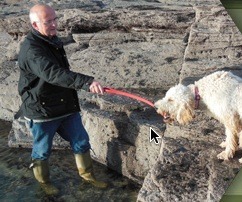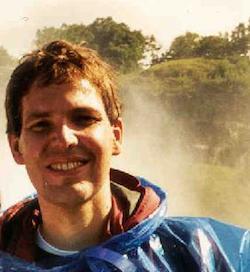Marc Abrahams's Blog, page 434
January 3, 2014
Unlucky for some (new themed-graveyard patent)
“[…] a need exists for a new and unique cemetery theme that may allow the deceased some options when considering where and how to be buried.“ This need may be met by a newly issued US patent, granted to inventor David Montgomery, of California. His invention suggests that replica theme-parks (e.g. baseball stadium, golf course, automobile racetrack or a casino &etc) might be configured as a cemetery. Thus, while bearing in mind that : “The human race has always desired the best ways to respect and bury their dead.” the park can also provide :“[…] adequate income and revenue in the way of advertising for the operator.” Here is the drawing that depicts the ‘Casino’ configuration, which provides space for memorial engravings atop the replica slot machines.
Consider the new patent in full here

Rock/Guitar/Tongue (study)
Playing a rock guitar solo with one’s tongue may be an impressive feat, but how are such solos actually rated by musicians (and non-musicians)?
Dr. Marco Lehmann, Dipl.-Psych., M.Sc. of the Fakultät für Erziehungswissenschaft, Psychologie und Bewegungswissenschaft der Universität Hamburg, along with Prof. Dr. Reinhard Kopiez, Professor für Musikpsychologie an der Hochschule für Musik, Theater und Medien Hannover, have recently performed a unique study which investigated not only tongued solos, but also finger-tapping and over-under techniques.
“We conclude that the technical difficulty of a performance is not self-evident to the recipient and depends on the rater’s degree of musical competence.“
See: ‘The influence of on-stage behavior on the subjective evaluation of rock guitar performances’ in: Musicae Scientiae, December 2013, vol. 17, no. 4, pp. 472-494.

January 2, 2014
Eating light (and nothing but!), as told by the winner who says she does not eat food
Jasmuheen explains, in this video interview from 2006, how she explains that she never eats food. A few years earlier, in the year 2000, Jasmuheen (formerly known as Ellen Greve) was awarded the Ig Nobel Prize for literature, for her book “Living on Light,” which explains that although some people do eat food, they don’t ever really need to.
BONUS: Sandra Lee, one of Jasmuheen’s opposite numbers explains a different, almost opposite approach to eating light.
BONUS (possibly unrelated): Robert Krulwich explains “Why Humans Are Like Light Bulbs”
BONUS: Video of Sathish Kumar eating tube light:
BONUS: Video of 2007 Ig Nobel medicine prize co-winner Dan Meyer (co-author of the BMJ study “Swordswallowing and Its Side Effects” eating a light bulb:

Marien Gadea Domenech joins Luxuriant Flowing Hair Club for Scientists (LFHCfS)
Marien Gadea Domenech has joined the Luxuriant Flowing Hair Club for Scientists (LFHCfS). She says:
I’m a neuropsychologist who deals with laterality in neurological diseases, psychosis and emotional process. My right brain awoke to art some time ago so I paint colours and take photos, including selfies of my reddish luxuriant flowing hair.
Marien Gadea Domenech, PhD, LFHCfS
Psychobiology Department
Psychology Faculty
Valencia University
Valencia, Spain


It’s all about the brand: Surgeon accused of branding his initials into a patient’s liver
 News reports say that Simon Bramhall [pictured here], Consultant HPB & Liver Transplant Surgeon in Birmingham, is accused of branding his initials into a transplant patient’s liver. The Telegraph‘s report, by Miranda Prynne, begins:
News reports say that Simon Bramhall [pictured here], Consultant HPB & Liver Transplant Surgeon in Birmingham, is accused of branding his initials into a transplant patient’s liver. The Telegraph‘s report, by Miranda Prynne, begins:
A surgeon has been suspended after allegedly branding his initials into a transplant patient’s liver. Consultant Simon Bramhall, 48, is accused of burning ‘SB’ onto a patient’s liver as he operated on him. The letters were spotted by a colleague during routine surgery on the unnamed patient. It is now feared the letters may have been imprinted onto hundreds of other transplant recipients….
Dr. Bramhall is a man of letters. His extensive CV lists numerous medical publications, including these:
Use of Marginal Donors.
Garcia CE, Bramhall S, Mirza DF.
Current Opinion in Organ Transplantation 2000;5:50-56.
Management of liver trauma.
Bramhall SR, Buckels J.
British Journal of Surgery 2000;87(4):517-518.
Abdominal wall burns; a late complication of liver transplant.
Singhal A, Bramhall SR, Mutimer D.
Liver Transplantation 2008;14(7):1065-1066.
(Thanks to investigator Scott Langill for bringing this to our attention.)
BONUS: Dr. Bramhill also wrote the colorfully titled:
Purse-string pancreaticojejunostomy following pancreatic resection.
Williams JG, Bramhall SR, Neoptolemos JP.
Digestive Surgery 1997;14:183-186.
BONUS (possibly unrelated):
“Branding of Vascular Surgery,” Bruce A. Perler, Perspectives in vascular surgery and endovascular therapy 20, no. 1 (2008): 6-8.

Maria de la Iglesia Vayá joins Luxuriant Flowing Hair Club for Scientists (LFHCfS)
Maria de la Iglesia Vayá has joined the Luxuriant Flowing Hair Club for Scientists (LFHCfS). She says:
I’m a computer scientist working in the field of functional magnetic resonance imaging (fMRI). I love studying mental disorders and human emotions through image processing techniques although I’m mainly interested in being a good sailor for letting the wind comb my luxuriant hair.
Maria de la Iglesia Vayá, PhD, LFHCfS
Biomedical Imaging Lab. FISABIO/CIPF
Brain Connectivity Lab. Neurological Impairment Program.
Prince Felipe Research Centre (CIPF)
C/Eduardo Primo Yúfera (Científic), nº 3 (Junto Oceanográfico)
Valencia, Spain


January 1, 2014
Why it will take 6,000 dead goats to build Britain’s high speed railway
A new UK railway project will indirectly require thousands of dead goats, explains the IanVisits Blog. It’s a matter of vellum:
If, or when the High Speed 2 railway is constructed, it will require roughly 6,000 dead goats. This curious statement comes from an old technicality as Acts of Parliament, when passed into law are still printed on vellum, which is typically made from goat skins. Two copies are printed, one for storage in the Victoria Tower, and another is sent to the National Archives in Kew.
Now, it has proven surprisingly difficult to work out the average number of pages of A4 that can be extracted from a single hide of skin, but I finally found a page that uses sheepskins as an example. That shows that the average sheep produces a single sheet that can be folded 8 times to produce 16 sides of vellum of roughly A4 size. All parliamentary bills need to be printed onto vellum, but the reason I am commenting on HS2 though, is because at 49,814 pages in length, the bill is the largest one ever presented to Parliament.
BONUS: What’s the difference between parchment, vellum, and paper? (A non-UK perspective)
BONUS: 300,000 to 450,000 cows per zeppelin, approximately
BONUS: The men who startled goats

Unthought knowns, unknown thoughts, and such stuff
As Distinguished Eagle Scout Donald Rumsfeld famously put things back in 2002 :
“There are known knowns (the things we know we know) but we also know there are known unknowns (that is to say we know there’s some things we do not know) but there are also unknown unknowns (the ones we don’t know we don’t know).”
Unintentionally or not, his perspicacious philosophical pronouncement overlooked one crucial category of ‘knowns’. They are the ‘Unthought Knowns’ – previously described in the work of professor Christopher Bollas via his seminal book ‘The shadow of the object: Psychoanalysis of the unknown thought’,
‘Unthought knowns’ might be thought of as ‘processes which are lived and known’ but which one does not think about. But, perhaps reflecting their inherent ‘unthoughtaboutness’, they did not receive very much attention in the academic literature after their first appearance in 1987. They did resurface, however, twenty years later in a paper from Ajeet Mathur and Sari Mattila ‘Thinking versus knowing: how unthought knowns embed collectively.’ (In: Remenyi, D. [ed.] ICICKM 2007, 4th International Conference on Intellectual Capital, Knowledge Management and Organisational Learning, 15-16 October, 2007, South-Africa Academic Conferences Limited. pp. 263-270)
The authors’ experimental work, which included investigations featuring action research methods based around fears, anxieties, fantasies, and speculations, bore fruit :
“The paper suggests ways to understand the collective embeddedness of unthought knowns and concludes that such embeddedness can be both enabling and disabling.”
Also don’t miss: ‘Applications of unawareness’

Rien: much ado about nothings [astronomical, cosmological study]
Nothing you can say about Rien can obscure the fact that Rien is obsessed with voids. Rien is at the University of Groningen. Rien is Rien van de Weygaert. Rien co-authored this study:
“A hierarchy of voids: much ado about nothing.” R.K. Sheth and Rien van de Weygaert [pictured here], Monthly Notices of the Royal Astronomical Society, vol. 350, no. 2, 2004, pp. 517-538. Rien is at the University of Groningen, the Netherlands. Rien and his co-author, who is not Rien, remark:
“We present a model for the distribution of void sizes and its evolution in the context of hierarchical scenarios of gravitational structure formation. We find that at any cosmic epoch the voids have a size distribution that is well-peaked about a characteristic void size that evolves self-similarly in time…. in our model, the void size distribution is a function of two parameters, one of which reflects the dynamics of void formation, and the other the formation of collapsed objects.”
BONUS: Je ne regrette rien:

December 31, 2013
Home-built suits of armor, built to survive against grizzlies or neighbors
Savor, if you will, the lurch of latter-day suits.
Compare and contrast these two descriptions of men who scrounged materials to build suits of armor to protect them against possibly malevolent forces. First, Troy Hurtubise, 1998 Ig Nobel Prize winner, who built a suit of armor to protect him against grizzly bears. Stephen Smith wrote about him in 1997, in Outside magazine:
In pursuit of his off-kilter dream — creating a suit of armor that can withstand the attack of a grizzly bear — Troy Hurtubise has endured much: Slugs in the chest from a 12-gauge shotgun at a range of 20 feet. Falling, on purpose, off the edge of the 150-foot-high Niagara Escarpment. Assaults from burly friends and relatives all too willing to cuff him repeatedly with road picks, knives, bows and arrows, two-by-fours. Eighteen times he has stood in the path of a three-ton pickup doing 30 miles per hour, and 18 times the truck has knocked him from here to next week. On several occasions, he has stood at attention while a 350-pound log, winched 30 feet up in a tree, swung down broadside to topple him like a human bowling pin. In each of these encounters, Hurtubise explains over oil-slicked restaurant coffee, he was safe inside his invention: the Ursus Mark VI Bearproof Suit, 147 pounds of titanium alloy, rubber, plastic, and chain mail standing seven feet, two inches tall. [The photo here is courtesy of National Film Board of Canada, which produced a documentary film about Troy: "Project Grizzly".]
The second is Tyler Smith, a survivalist who is the subject of a documentary by National Geographic. Craig Sailor writes about Smith, in the News Tribune:
He and his compatriots just fear what might happen if society breaks down. They plan on being survivors, not victims…. As part of his strategy, Smith and Pedrini are developing a suit of armor to wear on his foraging forays. Smith says his homemade protection will be bulletproof, lightweight and stronger than anything sold in a store…. The pair used salvaged and bought steel and aluminum. A steel grill from an old security gate makes up some of the protection. Smith wants the suit to weigh from 80 to 100 pounds. Smith used bathroom tiles wrapped in woven fiberglass and coated in roofing tar as one of the bullet-stopping layers. The suit must survive bullets from .22- and .30-06-caliber rifles and a 12-gauge shotgun, he says. In addition to those weapons Smith’s arsenal includes .270-, .30-30-, .223-caliber and AK-47 rifles and 9 mm and 45 mm handguns. On the TV show, Smith tests the suit by having Pedrini hit him with a rock, a pipe, an ax and a piece of timber. Finally, Smith has Pedrini shoot him in the chest point blank with a 12-gauge shotgun.
BONUS: Lt. Colonel Robert Bateman gives his take on the Smith approach.
VIDEOS: Troy in the documentary “Project Grizzly”:
BONUS: Follow-up (in 2001): When Troy met a kodiak bear
BONUS: Follow-up (in 2011): Troy’s New Book of Bear (and then some) Adventures

Marc Abrahams's Blog
- Marc Abrahams's profile
- 14 followers





